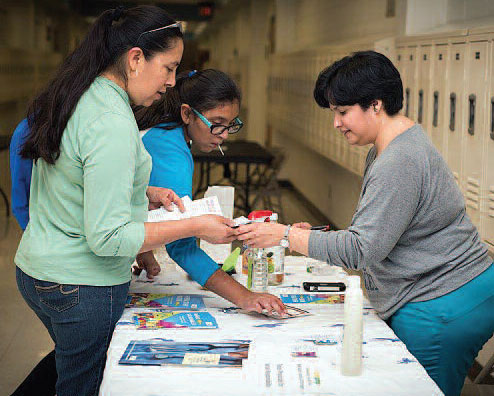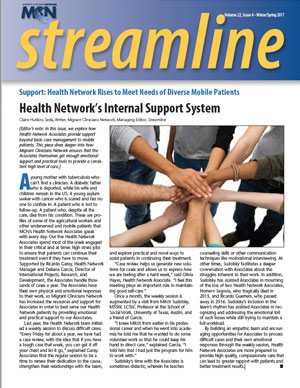Serving Patients with Diabetes, Limited Resources, and Lives on the Move
 By Jeremy Leake, Social Work Intern, Health Network
By Jeremy Leake, Social Work Intern, Health Network
As a social work intern, I began working for Migrant Clinicians Network’s Health Network from a learner’s standpoint – to educate myself on the agricultural worker population as a whole, and how I could help to bridge the gap in meeting their health needs. My perspective in serving these individuals has been enhanced by sixteen years of living as a diabetic, and offers a different approach in providing care through case management.
For several months, I served patients enrolled in Health Network for their various health needs, including tuberculosis, diabetes, and general health care. My curiosity in working with diabetic patients comes from a place of empathy in understanding the daily challenge involved in managing this condition. It is a full time job in itself. Aside from ensuring that these individuals have the education and medication that is vital to their health, there is much to say about the psychological and emotional health that can pose barriers to staying engaged in the changes in lifestyle that are necessary to effectively manage diabetes. “Diabetes burnout” is a construct that can be defined as occurring “when an individual with diabetes has the information (education) necessary to manage diabetes well, yet his or her psychological and emotional state(s) have become barriers to adequately engaging in the behavior necessary to effectively manage” the health condition.1 The possibility of burnout among diabetic patients is concerning, and should be kept in mind when working with individuals facing any change that functions as an obstacle to living a normal life.
In addition to learning from my MCN coworkers about how we can continue to improve our efforts to extend care to patients, I utilized theories and frameworks that I have learned throughout my coursework as a social work undergraduate student with my patients to begin to assess the extent to which patients’ basic needs are being met. These needs include food, shelter, safety, and the presence of strong support systems, with their health only being a fraction of need. In order to check in about patients’ needs, I referenced Maslow’s hierarchy of needs, which places basic human needs into five different tiers. The base of the hierarchy pyramid is an individual’s physiological well-being (food, water, shelter), followed by consecutive tiers of needs including safety, sense of self-belonging and love, self-esteem, and self-actualization.2 I incorporated prior knowledge of the patient’s background information (age, location, race, health, culture) and used motivational interviewing techniques to encourage them to feel comfortable in discussing any concerns or issues that might be present, including how we can help the patients help themselves. These tools that I learned, and have been able to use from my university coursework, complement the Health Network training that I received. Another quick, yet very efficient assessment tool that I began to use later in my internship was introduced to me and the rest of Health Network staff by my Field Instructor, Mitch Sudolsky, a clinical professor at the University of Texas and social work consultant with MCN. Ideas, Concerns, Expectations (ICE)3 assists case managers in understanding the patient’s needs, through learning their thoughts relating to what is going on with their body/health condition, what the patient’s biggest worry is (which may differ from the case manager’s), and what the patients are hoping that the case manager can do for them based on their discussion. This mutual understanding of patients’ needs aided me to help them by calmly addressing their most pressing worry, and making them aware that they can receive help for their needs. Additionally, this could result in an increased willingness of the patients to discuss other issues that may be present in their life. By using theories, frameworks, and assessment tools, I was able to understand that when patients are anxious, they may not listen well and may not adequately problem solve. We problem solve with the patients over the phone to help alleviate their burden. Afterward, they are more inclined to listen to our input, plans for continuation of care, and efforts to help.
According to this frame of thought, some agricultural workers are more likely to show decreased motivation in caring for their conditions, should their most basic needs not be met. This reduced focus on health is worsened by the stress, depression, and grief that accompany the inability to provide these basic needs for one’s self.4 Imagine a patient going to a clinic in hopes of obtaining care, and being informed that they must take a medication daily to keep themselves healthy. However, their anxieties and stress related to their inability to work or feed their child could be a more pressing need. By addressing and acknowledging the existence of a diabetic patient’s anxieties and stressors unrelated to their disease, the patient may feel heard and comforted by his or her case manager. As a result, the patient may be more likely to honestly disclose their struggles with diabetes management. Admittance to and disclosure of patients’ health care adherence difficulties is critical. Building rapport with patients could be a simple fix to helping them get on the right track, diverting them from the path that leads to burnout.
Reflecting on my internship, I have come to learn how patients that are mobile and diabetic could face even greater challenges in managing their health condition, because of the impacts of social determinants of health. Pulling in my personal experience as a diabetic, and my experience gained through this internship, I now have a greater understanding of the importance of the role of an advocate in a Health Network Associate. Advocating for patients could actually be a determinant of whether or not they are able to maintain their strict diabetes (or other health care) regimens. Putting in the effort to assist patients in self-care relating to their health needs ultimately increases the likelihood that they can make it to work, and succeed at their jobs, which may enhance their overall quality of life.
Resources
Watch MCN’s archived webinar in Spanish, “The Role of Community Health Workers and Diabetes,” at https://goo.gl/rZh2XC.
MCN recently ran a blog post on Group Health Research Institute’s diabetes self-management program, which dives into:
- Exploration of long-term solutions to continue trainings to serve the underserved patients with diabetes
- Community health advocate training
- Provision of diabetes self-management workshops in English and Spanish
- Skills to manage diabetes at home between clinic visits
Read the post on the MCN blog: https://goo.gl/aaVmuo.
References
- Stoeckel M, Duke D. Diabetes and Behavioral Learning Principles: Often Neglected yet Well- Known and Empirically Validated Means of Optimizing Diabetes Care Behavior. Curr Diab Rep. 2015;15(7):39.
- Poston B. An Exercise in Personal Exploration: Maslow’s Hierarchy of Needs. http://www.ast.org/pdf/308.pdf. Accessed December 14, 2016.
- Sudolsky, Mitch. Clinical Professor at the University of Texas at Austin.
- Larocco JM, House JS, French JR. Social support, occupational stress, and health. J Health Soc Behav. 1980;21(3):202-18.
Read this article in the Spring 2017 issue of Streamline here!
Sign up for our eNewsletter to receive bimonthly news from MCN, including announcements of the next Streamline.
Return to the Streamline Spring 2017 Table of Contents.
